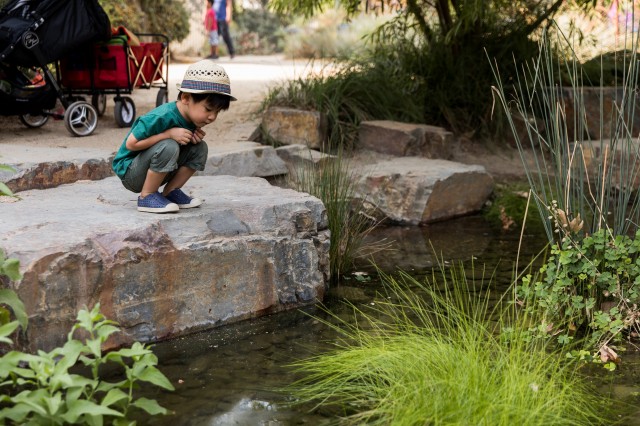In collaboration with Descanso Gardens
Overview
In this nature study, students will have the opportunity to choose a special spot in their outdoor space to observe on a regular basis. They will record observations, questions, and artwork in nature journals. This activity can be done anytime in any variation of outdoor space — a patch of grass, a few trees, or a flowerbed is all you need.
Learning Objectives
- Students will strengthen scientific observation skills by looking and listening closely.
- Students will practice writing skills by describing their observations in the form of a journal entry, prose, or poetry.
- Students will practice life drawing skills and express themselves through art.
- Students will cultivate a sense of ownership of their space and stewardship of the natural world.
See learning standards at the bottom.
Duration
5-10 minutes to introduce the activity and find places (first time only)
10-20 minutes for activity
5 minutes to share out at the end
Materials
- Paper, journal, or notebook
- Drawing/writing utensils
- Magnifying glass (optional)
- Thermometer (optional)
Activity
- Introduce the activity to your students:
“Each of you is going to find a place in our [garden, playground, yard, etc.] to quietly observe and reflect on what is around you. This will be your spot for the whole time we will be conducting our study [over the next week, month, school year]. We are going to spend 3 minutes finding a spot, you are going to observe your surroundings for 15 minutes, then we will spend 5 minutes sharing with the group. Look and listen closely (touch plants gently if allowed) and draw and write about what you notice. Each time you return to your place, take notes about what has changed.”
- Students can consider the following prompts as a framework for their nature study: “I notice...I wonder...it reminds me of…”
- Give parameters for where students can search for a place. On the first day, ask them what a good place in the world should have (shade/sun, comfortable spot on the ground to sit, something to observe, room to spread out a bit). Remind them that this is going to be their place for quite awhile so they should spend a few minutes finding a place they really like.
- Give students 5/3/2 minute warnings that the activity is ending. Use a bell, clap, or your favorite attention-getter to let students know it’s time to gather and share.
- Ask who would like to share their observations. After the first time, start asking students what changes they noticed or what stayed the same.
Activity Tips
- This activity works best if it becomes a regular part of your daily or weekly routine. Utilize it as a start and/or end to students’ day or as a transitional activity.
- Think about different ways students can express themselves through this activity. Can they write a poem on one of their observation days? Draw a comic of what they see? Craft a short story about characters in the garden? Quick-write colors they notice?
- Store nature journals or notebooks and other supplies somewhere students can easily access them when it's time for the activity. Getting and putting supplies away becomes part of the routine.
- Remind students to write down the date, time, and even the weather so they can easily track the changes that happen in their place.
- Optional extensions for 5th grade and up:
- Lengthen the time to 20-30 minutes.
- Integrate the activity into a larger journaling project or determine a research question and use observations as data points for a research project.
- Have students focus on one plant in their place (ex. if you are studying trees, each student would choose 1 tree to observe) and note life cycle, seasonal changes, interactions between different plant and animal species, etc.
NGSS Tie-Ins
Science and Engineering:
Asking questions
Analyzing and interpreting data
Engaging in argument from evidence
Obtaining, evaluating, & communicating information
Cross-cutting Concepts:
Patterns
Cause and effect
System and system models
VAPA Tie-Ins
Aesthetic perception, creative expression, connections, relationships, applications

